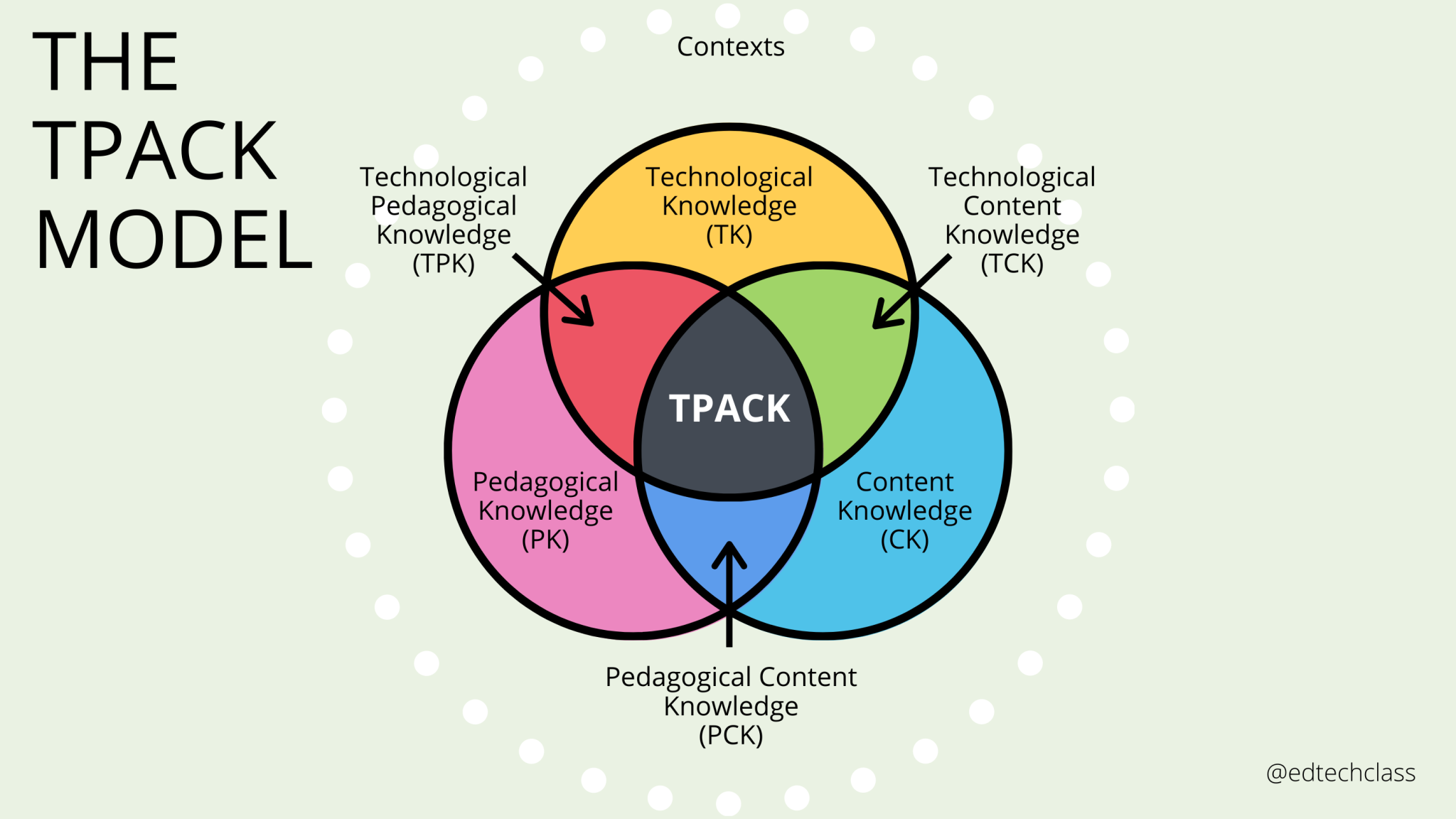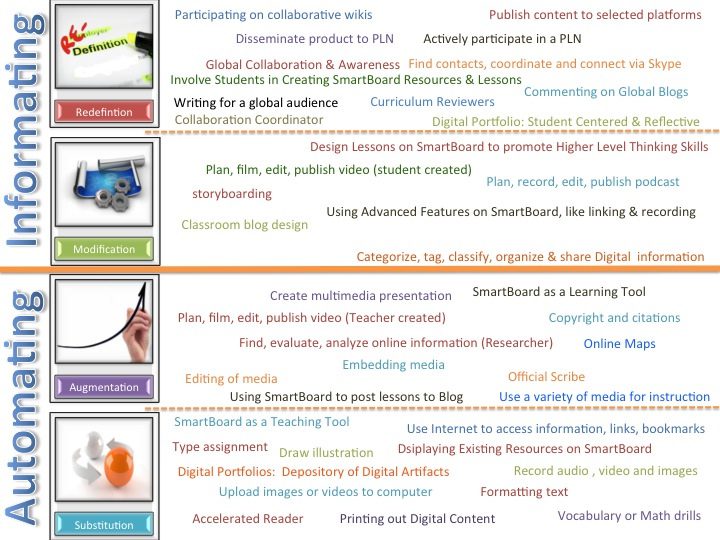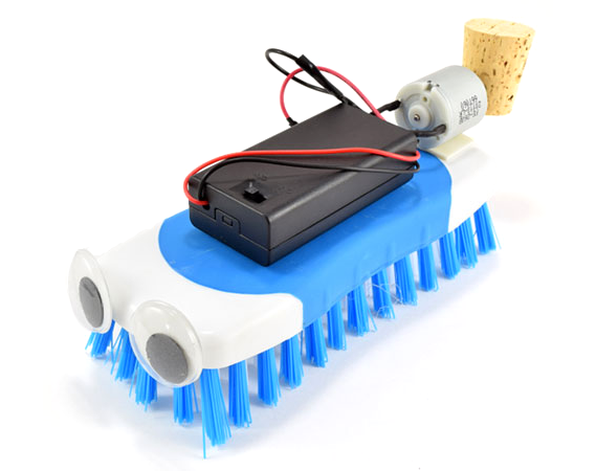We have looked at two educational technology frameworks: the TPACK Framework, and the SAMR Model.
TPACK FRAMEWORK
About the TPACK Framework
My learning reflections

I like the TPACK model as it highlights the intersections of different types of knowledge to consider when implementing technology in the classroom. Are we using tech to access content, to help teach, to learn about ICT, or all of the above?
TPACK stands for technological pedagogical content knowledge and it’s a model or framework to guide teachers in how to implement technology in the classroom in a way that provides a high-quality educational experience for students (EdTech, 2021). Attributed to Punya Mishra and Matthew J. Koehler in 2006, it focuses on the intersections of three types of knowledge: technological knowledge, content knowledge, and pedagogical knowledge.
I can use this model to support lesson planning. I would keep the focus on enhancing students’ learning experience. How can I make lessons more interactive with technology, rather than just replacing physical paper with digital documents?
For example, Google slides can be used by students in a sandbox school environment to build presentations to share in class, complemented by a search engine to research content and find photos. It’s important to also teach students to use their own words rather than copy and paste so they are thinking and learning about the content. Teaching about digital rights and not taking someone’s content without attribution or permission is also important.
“..the technology being implemented must communicate the content and support the pedagogy in order to enhance students’ learning experience.”
Kurt, 2018
According to this video from PowerSchool (2022), fewer educators are familiar with or use TPACK and SAMR is more widely used. It’s considered easier but perhaps too simple?
SAMR MODEL
About the SAMR Model
My learning reflections

The SAMR model is often presented as a progression, but my key takeaway is that it doesn’t have to be linear and you can pick and choose which approach(es) best suit a particular activity. We do see technology used more as an enhancement to teaching and learning, as transformation probably takes more time and effort to implement.
The SAMR model was developed in 2010 by Dr Reuben Puentedura to demonstrate the impact of technology on teaching and learning. It helps educators consider how technology can be used for learning in the classroom through substitution, augmentation, modification, or redefinition (Fastiggi, 2015; Terada, 2020). Teachers often focus on the ‘automating’ or ‘enhancement’ applications of technology through substitution or augmentation. A more sophisticated integration of technology in the classroom considers opportunities for modification or redefinition of learning activities.

I’ve seen technology used as substitution and enhancement in a classroom. It can work well, but I wonder about the downsides. For example, if students are using digital media for projects, they are not physically writing, drawing, cutting or sticking which can be rewarding in itself. For younger students in particular, developing fine motor skills in the hands is an important learning outcome (not just using a mouse and keyboard).
I’ve also seen technology use backfire, like using Google Translate in a grade 5 beginner French class. Students don’t know enough of the language to know whether the translation is correct in the context they will be using it. For example, ‘house’ is ‘maison’, but when I put it in Google Translate, the tool gives me ‘loger’ which means ‘lodge’ or ‘to accommodate’.
I think where technology implementation becomes more exiting and engaging for students is when it’s used to modify or redefine learning activities. Some of the digital creative projects like creating a podcast, a video or a blog design could be great fun and inquiry-led. Other activities such as using Scratch for a coding project, or learning about robotics and programming a robot in class would also appeal, although the implementation of these may need to be supported by professional development opportunities for educators to build confidence in these areas.
“Good technology integration isn’t about living at the top of the SAMR model; it’s about being aware of the range of options and picking the right strategy – or strategies – for the lesson at hand.”
Terada, 2020
There are many resources available to educators to learn about how to integrate technology into their classroom. I am concerned about the time this takes and whether there are dedicated professional development days planned yearly to focus on latest skills/developments in edtech and how to apply them in the classroom.
This blog has some interesting robotics lessons and activities if educators have the time, resources and motivation to incorporate these into their learning plans: https://www.sciencebuddies.org/blog/robotics-lessons
References
Cowen, A. (2023, March 23). Robotics projects, lessons, and activities for teachers. ScienceBuddies. https://www.sciencebuddies.org/blog/robotics-lessons
EdTech. (2021, June 30). All about TPACK: a teacher’s guide to the TPACK tech integration model. EdTech Classroom. https://edtech-class.com/2021/06/30/all-about-tpack-a-teachers-guide-to-the-tpack-tech-integration-model/
Fastiggi, W. (2015, June 11). The SAMR model. Technology for learners. https://technologyforlearners.com/the-samr-model/
Kurt, S. (2018, May 12). TPACK: technological pedagogical content knowledge framework. Educational Technology. https://educationaltechnology.net/technological-pedagogical-content-knowledge-tpack-framework/
PowerSchool. (2022, April 20). The TPACK Framework explained (with classroom examples). PowerSchool. https://www.powerschool.com/blog/the-tpack-framework-explained-with-classroom-examples/
Terada, Y. (2020, May 4). SAMR: a powerful model for understanding good tech integration. Edutopia. George Lucas Educational Foundation. https://www.edutopia.org/article/powerful-model-understanding-good-tech-integration/
Walsh, K. (2015, April 20). 8 examples of transforming lessons through the SAMR cycle. Emerging Ed Tech. https://www.emergingedtech.com/2015/04/examples-of-transforming-lessons-through-samr/
